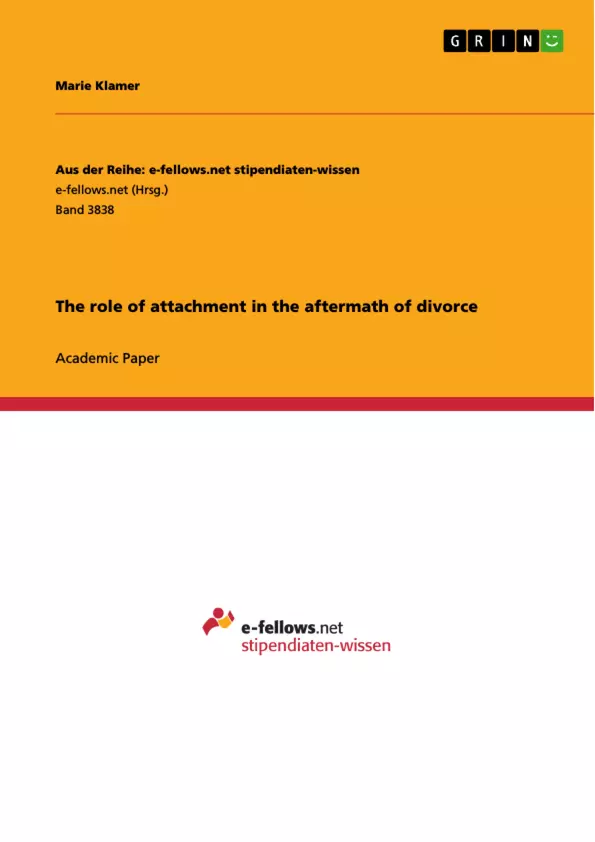Divorce is a complex and emotional experience for many individuals as it involves the loss of a vital attachment bond within adulthood. Therefore, the perspective of attachment theory is highly applicable to the study of divorce. Attachment theory is a relevant framework for marital separation in two main ways. First, attachment theory provides a normative perspective on how individuals deal with the loss of an attachment figure. Second, individual differences in attachment behaviors can account for variations in people’s responses to divorce. This paper will discuss both of these perspectives from the theoretical background and review relevant empirical work. For reasons of space, the effects of divorce on children and adolescents are not considered in this paper. The focus is on the adult perspective.
Inhaltsverzeichnis (Table of Contents)
- Introduction
- The theoretical background of the normative process
- The theoretical background of individual attachment differences
- Empirical work on the normative processes
- Empirical work on the individual attachment differences
Zielsetzung und Themenschwerpunkte (Objectives and Key Themes)
This paper explores the role of attachment theory in understanding the complex experience of divorce. It examines both the normative process of dealing with the loss of an attachment figure and how individual differences in attachment styles influence responses to divorce.
- The normative process of separation and loss as described by attachment theory
- The role of individual attachment styles in marital stability and divorce coping mechanisms
- The impact of divorce on mental and physical health
- The importance of self-concept clarity and narrative coherence in the detachment process
- The relationship between attachment insecurity and marital dissatisfaction
Zusammenfassung der Kapitel (Chapter Summaries)
The paper begins by outlining the relevance of attachment theory to divorce, emphasizing the loss of a vital attachment bond and the normative process of separation. It discusses Bowlby's theory of separation and its application to divorce, highlighting the potential for anger and resistance in response to the loss. The importance of reorganization and detachment for adjusting to divorce is emphasized, with self-concept clarity and narrative coherence being presented as crucial mechanisms.
Next, the paper delves into individual attachment differences, explaining the concept of attachment styles and their influence on relationships and divorce. It explores the link between attachment security and marital stability, contrasting the effects of anxiety and avoidance on coping with separation. The paper highlights research suggesting that attachment insecurity can contribute to marital dissatisfaction but doesn't necessarily lead to divorce.
Moving into empirical research, the paper examines studies supporting the idea that divorce is a challenging process for most individuals, often associated with negative health outcomes. It then delves into research supporting the importance of self-concept clarity and narrative coherence in the detachment process following divorce, highlighting findings linking these factors to reduced emotional distress and better mental health outcomes.
Finally, the paper explores research on the impact of attachment styles on marital stability and divorce coping mechanisms. It highlights studies linking insecure attachment styles to negative conflict behaviors and poorer mental health post-divorce. The paper also discusses research suggesting that secure attachment may provide a protective factor in relationships, while anxiety and avoidance may lead to maladaptive coping strategies during separation.
Schlüsselwörter (Keywords)
Attachment theory, divorce, separation, attachment styles, secure attachment, insecure attachment, anxiety, avoidance, self-concept clarity, narrative coherence, marital stability, coping mechanisms, mental health, emotional distress.
- Arbeit zitieren
- Marie Klamer (Autor:in), 2021, The role of attachment in the aftermath of divorce, München, GRIN Verlag, https://www.grin.com/document/1033883



